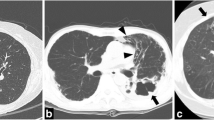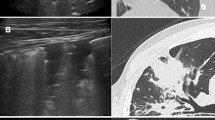Abstract
Purpose
To identify the most frequent radiological findings of pulmonary tuberculosis using CT of the chest, to determine those with the highest degree of correlation, and, if possible, to identify the most suggestive radiological findings for acid-fast bacilli (AFB) positive disease.
Materials and methods
The radiological and clinical data of 49 patients submitted to CT during diagnosis were retrospectively analysed. The association between findings was assessed using Fisher’s exact test, while correlation at CT scan was evaluated with the Spearman analysis.
Results
Bronchiectasis/bronchioloectasis (89.8%), nodule(s) (81.6%), tree-in-bud (TIB), and consolidation (79.6% each) figured among the most common parenchymal findings. Lymphadenopathy (26.5%) was the most common nodal finding. TIB and cavity showed the highest correlation (r = 0.577), followed by TIB and bronchi(olo)ectasis (r = 0.498), TIB and consolidation (r = 0.497), nodule(s), and ground glass opacity (r = 0.488). High correlation was found in only the seven most frequent parenchymal findings. Consolidation, TIB, and cavity were useful to predict the AFB stain positivity.
Conclusions
Our series confirms the extreme heterogeneity of pulmonary tuberculosis. It also proves there are couple of findings which can drive us to the right diagnosis. While a triad of findings predicts AFB positivity, we have not found any predictive sign of AFB negativity; consequently, all patients with suspected imaging and clinical findings for TB should be isolated.






Similar content being viewed by others
References
ECDC Surveillance Report (2016) Tuberculosis surveillance and monitoring in Europe. https://ecdc.europa.eu/en. Accessed 28 June 2018
Tanini T, Lorini C, Santomauro F, Comodo N, Bonaccorsi G (2012) Tuberculosis in Tuscany: epidemiology and drug resistance. Ig Sanita Pubbl 68(5):645–655
Scotto G, Fazio V, Lo Muzio L (2017) Tuberculosis in the immigrant population in Italy: state-of-the-art review. Infez Med 25(3):199–209
World Health Organization (2017) Global tuberculosis report 2017. http://www.who.int/tb/en/. Accessed 28 June 2018
World Health Organization (2017) Global tuberculosis report 2016. http://www.who.int/tb/en/. Accessed 01 Oct 2017
Zammarchi L, Bartalesi F, Bartoloni A (2014) Tuberculosis in tropical areas and immigrants. Mediterr J Hematol Infect Dis 6(1):e2014043
Jensen PA, Lambert LA, Iademarco MF, Ridzon R (2005) CDC guidelines for preventing the transmission of Mycobacterium tuberculosis in health-care-settings. MMWR Recomm Rep 54(RR-17):1–141
Ravenel JG, Chung JH, Ackman JB, de Groot PM, Johnson GB, Jokerst C et al (2017) ACR appropriateness criteria (®) imaging of possible tuberculosis. J Am Coll Radiol 14(5S):S160–S165
NICE NG33 (2016) Tuberculosis prevention, diagnosis, management and service organisation. https://www.nice.org.uk/guidance/ng33. Accessed 28 June 2018
Rozenshtein A, Hao F, Starc MT, Pearson GD (2015) Radiographic appearance of pulmonary tuberculosis: dogma disproved. AJR Am J Roentgenol 204(5):974–978
Hansell DM, Bankier AA, MacMahon H, McLoud TC, Müller NL, Remy J (2008) Fleischner Society: glossary of terms for thoracic imaging. Radiology 246(3):697–722
Miller WT Jr, Panosian JS (2013) Causes and imaging patterns of tree-in-bud opacities. Chest 144(6):1883–1892
Ellis SM (2004) The spectrum of tuberculosis and non-tuberculous mycobacterial infection. Eur Radiol Suppl 3:E34–E42
Yeh JJ, Neoh CA, Chen CR, Chou CY, Wu MT (2014) A high resolution computer tomography scoring system to predict culture-positive pulmonary tuberculosis in the emergency department. PLoS ONE 9(4):e93847
Yeh JJ, Chen SC, Teng WB, Chou CH, Hsieh SP, Lee TL et al (2010) Identifying the most infectious lesions in pulmonary tuberculosis by high-resolution multi-detector computed tomography. Eur Radiol 20(9):2135–2145
Yeh JJ, Yu JK, Teng WB, Chou CH, Hsieh SP, Lee TL et al (2012) High-resolution CT for identify patients with smear-positive, active pulmonary tuberculosis. Eur J Radiol 81(1):195–201
Yeh JJ, Chen SC, Chen CR, Yeh TC, Lin HK, Hong JB et al (2014) A high-resolution computed tomography-based scoring system to differentiate the most infectious active pulmonary tuberculosis from community-acquired pneumonia in elderly and non-elderly patients. Eur Radiol 24(10):2372–2384
Ors F, Deniz O, Bozlar U, Gumus S, Tasar M, Tozkoparan E et al (2007) High-resolution CT findings in patients with pulmonary tuberculosis: correlation with the degree of smear positivity. J Thorac Imaging 22(2):154–159
Yuan MK, Chang CY, Tsai PH, Lee YM, Huang JW, Chang SC (2014) Comparative chest computed tomography findings of non-tuberculous mycobacterial lung diseases and pulmonary tuberculosis in patients with acid fast bacilli smear-positive sputum. BMC Pulm Med 14:65
Yoon JY, Lee IJ, Im HJ, Lee K, Lee Y, Bae SH (2013) CT findings in apical versus basal involvement of pulmonary tuberculosis. Diagn Interv Radiol 19(2):85–90
Nakanishi M, Demura Y, Ameshima S, Kosaka N, Chiba Y, Nishikawa S, Itoh H, Ishizaki T (2010) Utility of high-resolution computed tomography for predicting risk of sputum smear-negative pulmonary tuberculosis. Eur J Radiol 73(3):545–550
Lee JJ, Chong PY, Lin CB, Hsu AH, Lee CC (2008) High resolution chest CT in patients with pulmonary tuberculosis: characteristic findings before and after antituberculous therapy. Eur J Radiol 67(1):100–104
Chu HQ, Li B, Zhao L, Huang DD, Zhang ZM, Xu JF et al (2015) Chest imaging comparison between non-tuberculous and tuberculosis mycobacteria in sputum acid fast bacilli smear-positive patients. Eur Rev Med Pharmacol Sci 19(13):2429–2439
Rizzi EB, Schininà V, Cristofaro M, Goletti D, Palmieri F, Bevilacqua N et al (2011) Detection of pulmonary tuberculosis: comparing MR imaging with HRCT. BMC Infect Dis 11:243
Matsuoka S, Uchiyama K, Shima H, Suzuki K, Shimura A, Sasaki Y et al (2004) Relationship between CT findings of pulmonary tuberculosis and the number of acid-fast bacilli on sputum smears. Clin Imaging 28(2):119–123
Ko JM, Park HJ, Kim CH, Song SW (2015) The relation between CT findings and sputum microbiology studies in active pulmonary tuberculosis. Eur J Radiol 84(11):2339–2344
Kim YK, Hahn S, Uh Y, Im DJ, Lim YL, Choi HK et al (2014) Comparable characteristics of tuberculous and non-tuberculous mycobacterial cavitary lung diseases. Int J Tuberc Lung Dis 18(6):725–729
Author information
Authors and Affiliations
Corresponding author
Ethics declarations
Conflict of interest
All authors declare that they do not have conflict of interest.
Ethical standards
This article does not contain any studies with animals performed by any of the authors. All procedures performed in studies involving human participants were in accordance with the ethical standards of the institutional and/or national research committee and with the 1964 Helsinki Declaration and its later amendments or comparable ethical standards. On 28 May 2018, the study obtained the approval of the Local Ethics Committee (protocol #12819).
Informed consent
Informed consent was obtained from all individual participants included in the study. All patients had provided their written informed consent for submission of their chest CT and, if necessary, of an iodinated contrast agent, according to the principles of the Declaration of Helsinki. Patient privacy was maintained (the reviewers knew only the code of the anonymized DICOM files), and patient care was not impacted.
Additional information
Publisher's Note
Springer Nature remains neutral with regard to jurisdictional claims in published maps and institutional affiliations.
Rights and permissions
About this article
Cite this article
Carlesi, E., Orlandi, M., Mencarini, J. et al. How radiology can help pulmonary tuberculosis diagnosis: analysis of 49 patients. Radiol med 124, 838–845 (2019). https://doi.org/10.1007/s11547-019-01040-w
Received:
Accepted:
Published:
Issue Date:
DOI: https://doi.org/10.1007/s11547-019-01040-w




